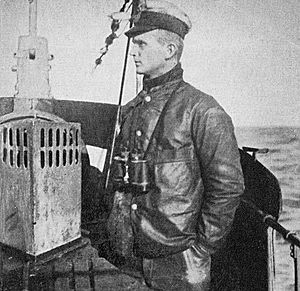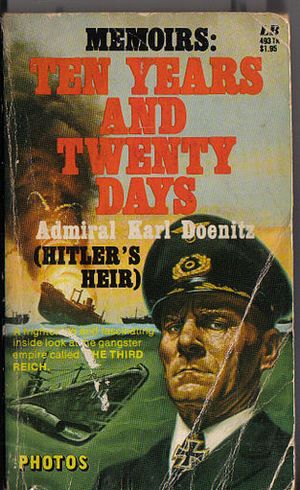Karl Dönitz facts for kids
Quick facts for kids
Karl Dönitz
|
|
|---|---|

|
|
| 4th President of Germany | |
| In office 30 April 1945 – 23 May 1945 |
|
| Preceded by | Adolf Hitler Führer und Reichskanzler |
| Succeeded by | Allied military occupation 1945-1949 Theodor Heuss (FRG) Wilhelm Pieck (GDR) |
| Personal details | |
| Born | 180px 16 September 1891 Berlin, German Empire |
| Died | 24 December 1980 (aged 89) Aumühle, near Hamburg, West Germany |
| Resting place | 180px |
| Nationality | German |
| Political party | None |
| Parent |
|
| Signature |  |
Karl Dönitz (born September 16, 1891 – died December 24, 1980) was an important German naval leader. He was in charge of the German Navy, called the Kriegsmarine, during the second part of World War II. Dönitz also served as the President of Germany for 23 days after Adolf Hitler died. People sometimes called him "der Löwe," which means "the Lion."
Contents
Karl Dönitz was born in Berlin, Germany. He joined the German Navy in 1911. During World War I, he first served on large ships. Later, he moved to submarines, known as U-boats.
After the war, he stayed in the navy. He rose through the ranks in both the Reichsmarine (the navy of the Weimar Republic) and the Kriegsmarine (the navy of Nazi Germany). He eventually became a very high-ranking officer, a Grand Admiral.
Dönitz became the Commander of Submarines. Later, he was made Commander-in-Chief of the entire German Navy. He got this important job even though he was never a member of the Nazi Party.
Under his command, the U-boat fleet fought in the Battle of the Atlantic. This was a long and difficult battle in the ocean. He also briefly served as Reichspräsident (President) for 23 days. This happened after Adolf Hitler's death. At the end of the war, he became a prisoner of the British.
After the War and Trial
After World War II, Dönitz was put on trial at the Nuremberg Trials. He was found responsible for some actions during the war. He was sentenced to ten years in prison.
One of his orders was for submarines to attack ships without warning. This was against an international agreement from 1936. However, during his trial, it was shown that other countries had also done similar things. Because of this, this specific action did not change his sentence.
Later Life and Books
Karl Dönitz was released from prison on October 1, 1956. He then retired to a small village called Aumühle in northern West Germany. There, he wrote two books about his life.
His first book was called Memoirs: Ten Years and Twenty Days. It was published in Germany in 1958. This book shared his experiences as a U-boat commander for ten years and as President for twenty days. In the book, Dönitz talked about the Nazi government. He also said that dictatorships are not good ways to govern.
Dönitz's second book, My Ever-Changing Life, is not as well known. It covers the events of his life before 1934. This book came out in 1968. In 1973, he appeared in a TV show called The World at War. This was one of the few times he was on television.
Family Life
On May 27, 1916, Karl Dönitz married a nurse named Ingeborg Weber. She was the daughter of a German general. They had three children together. They raised their children as Protestant Christians.
In 1937, Dönitz's daughter Ursula married a U-boat commander named Günther Hessler. Sadly, both of Dönitz's sons died during World War II.
Final Years
Karl Dönitz lived a quiet life in Aumühle after his release from prison. He sometimes wrote letters to people interested in German naval history. He passed away from a heart attack on December 24, 1980.
He was the last German officer to hold the rank of Großadmiral. Many former servicemen and naval officers from other countries came to his funeral. They wanted to show their respect. He was buried in Waldfriedhof Cemetery in Aumühle. No military honors were given at his funeral. Soldiers were not allowed to wear their uniforms. More than 100 people who had received the Knight's Cross of the Iron Cross also attended.
Images for kids
-
Dönitz watching the submarine U-94 arrive in St Nazaire, France, in June 1941.
-
The Möltenort U-Boat Memorial near Kiel in northern Germany. About 30,000 men died under Dönitz's command.
-
Adolf Hitler meeting with Dönitz in the Führerbunker in 1945.
-
Dönitz and other officers giving the Nazi salute in 1941.
-
His grave in Aumühle, east of Hamburg.
See also
 In Spanish: Karl Dönitz para niños
In Spanish: Karl Dönitz para niños











